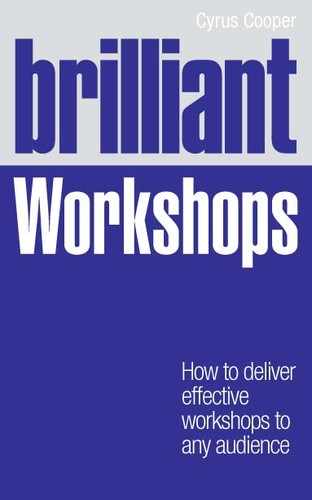abstract conceptualisation
activist learning style, 2nd
Adaption-Innovation Inventory
aggressive individuals, dealing with
ambience
Amiable style, 2nd, 3rd
Analytical style, 2nd, 3rd
Angelou, M.
argument
presenting both sides
presenting one side
attention, reasons for losing
audience/participants
expectations
identifying
introducing to each other
knowing
reasons for participation
reasons for presence
roles of resistance
behavioural types, assessment tools see DiSC
Belbin, M., 2nd
Belbin Self-Perception Inventory
Belbin team roles
boardroom layout
body language
nerves
Bolton, R. & Bolton, D.G.
Bonaparte, N.
boundaries of discussion
brainstorming
breaks
briefing, planning and design
cabaret-style room layout
case studies
challenging individuals, dealing with
circular room layout
CIRO model of evaluation
Clayton, M., Brilliant Influence
closed questions, 2nd
commitment plan
communication
body language
eye contact
facial expressions, impact compared with spoken words
non-verbal
voice
tone of
use of
concentration
peaks
reasons for loss of
concrete experience
content, delivering relevant
contract
Cossman, E. J.
costs of workshop
direct costs
indirect costs
cultural architects
delivery
distractions
group dynamics see separate entry
memorising words
nerves – controlling
opening – challenge vs support model
standing or sitting
DiSC, 2nd
distractions
Driver style, 2nd
e-learning
email prompts
embarrassing moments
Emerson, R.W.
energisers
birthday line-up
tennis ball challenge
when needed
energy levels, assessing
equipment, position in room
evaluation
CIRO model
deciding whether to use
during workshop
five level
Kirkpatrick’s model
learning
learning transfer
planning and design stage
post-workshop, 2nd
reaction
results
evaluation forms, 2nd, 3rd
commitment plan
designing
examples
generic
importance of – convincing participants
online
open and closed questions
opening question
rating scale questions
stop/start/continue
word circling
evangelists, 2nd
‘explosive’ individuals, dealing with
Expressive style, 2nd, 3rd
eye contact
Facet 5, 2nd
facial expressions, impact compared with spoken words
facilitation, effective – key ingredients
facilitator
definition
role
feedback
during workshop
post-workshop
five Ps
flipcharts, 2nd
floating voters, 2nd
Forbes, M.
freebies
gestures
gimmicks
definition
goals and objectives, SMART
ground rules
when not to use
when to use
group discussions
group dynamics, managing
Adaption-Innovation Inventory
ambience
asking and answering questions
Bolton and Bolton model
dealing with challenging individuals
facilitator styles for stages of Tuckman’s model
forming stage (Tuckman’s model ), 2nd, 3rd
ground rules
group styles
norming stage (Tuckman’s model ), 2nd, 3rd, 4th
performing stage (Tuckman’s model ), 2nd, 3rd, 4th
storming stage (Tuckman’s model ), 2nd, 3rd, 4th
Tuckman’s model of team development
group exercises
handouts, 2nd
vs workbooks
happy sheets see evaluation forms
‘helpless’ individuals, dealing with
Heraclitus
Honey and Mumford Learning Styles Questionnaire
horseshoe room layout
human bingo
hydration, controlling nerves
icebreakers
definition
examples
human bingo
introduce your partner
quiz
reasons for use
three facts game
three facts team game
ideas, structuring in talk
internet
introduce your partner game
introductory session
‘it won’t work’ individuals, dealing with
KAI
Kirkpatrick, Prof D.
evaluation model
Kirton, M.J.
‘know-it-all’ individuals, dealing with
Kolb, D., theory of experiential learning
learning
evaluation
Kolb’s theory of experiential learning
post-workshop
learning gap, identifying
learning interventions – types of
learning nudges, 2nd
learning styles
activists, 2nd
Honey’s and Mumford’s questionnaire
identifying before workshop
pragmatists, 2nd, 3rd
reflectors, 2nd
theorists, 2nd, 3rd
learning transfer, evaluation
lectures
Lewis, C.
Link, H.C.
Mahfouz, N.
Marston, W.M., The Emotions of Normal People
Mehrabian, Prof A.
memorising words
messages, key, 2nd, 3rd
mistakes – examples
motivational assessment tool, Strengths Deployment Inventory (SDI )
mousemats, as learning nudges
mugs, as learning nudges
music, impact of
needs of client, defining/identifying
contract
initial request
key questions
questioning skills
training/facilitation planning template
nerves – controlling
breathing
hydration
internal warm-up
physical warm-up
‘no delivery’ individuals, dealing with
non-verbal communication
notes, using
open questions, 2nd
opening – challenge vs support model
opening sentences
participants see audience/participants
pens, as learning nudges
perceptual positioning
Peters, T.
planning and design
briefing
first draft
learning interventions – types of
pre-work
proposal
seminar
structuring talk
supporting tools
templates
up-front evaluation
post-workshop learning
post-workshop prompts
posture
PowerPoint, 2nd, 3rd, 4th
pragmatist learning style, 2nd, 3rd
pre-work
preparation of presentation
presentations, 2nd
content
eye contact
gestures
impact
impression – creating right
key messages, 2nd
notes – using
objectives
opening sentences
posture
PowerPoint, 2nd
preparation
prompt cards, using
questions, anticipation
rehearsal
room layout – checking
script, using
venue
visual aids see separate entry
words – choosing
see also communication; delivery
printing
colour vs black and white
‘procrastinators’, dealing with
prompt cards
proposal, planning and design
props
protesters, 2nd
psychometric profiling tool, Facet 5
questioning skills
closed questions, 2nd
counter-productive questions
open questions, 2nd
questions
answering
anticipation of
asking for
listening to
types of person asking
Rae, W.L.
rapport, building
reaction, evaluation
reflective observation
reflector learning style, 2nd
rehearsal, 2nd
resistance, identifying roles of
resources, supporting
gimmicks
learning nudges
printing
TQC model
workbooks vs handouts
results, evaluation
Return on Investment (ROI )
role plays
room
boardroom layout
cabaret-style layout
circular layout
distractions – reducing
equipment – placing
heat and light levels
horseshoe room layout
layout
checking
options
number required
position of audience
size
temperature
rude individuals, dealing with
saboteurs, 2nd
script, using
self-assessment
perceptual positioning
seminar, planning and design
silent type, dealing with
SMART
snacks
social styles, Bolton and Bolton model
spoken words, impact compared with facial expressions
stop/start/continue, evaluation forms
Strengths Deployment Inventory (SDI )
supporters, 2nd
talk
beginning, 2nd, 3rd
end, 2nd, 3rd, 4th
grabbing audience’s attention
middle, 2nd, 3rd, 4th
planning and design
presenting both sides of argument
presenting one side of argument
team roles, Belbin
teambuilding, Belbin team roles
tennis ball challenge
theorist learning style, 2nd, 3rd
‘thinks-they-know-it-all’ individuals, dealing with
three facts game
three facts team game
Time vs Quality vs Cost (TQC) model
tone of voice
tools, supporting
trainer
definition
role
training, compared with facilitation
training/facilitation planning template
Tuckman, B., team development model
facilitator styles for stages
forming stage, 2nd, 3rd
norming stage, 2nd, 3rd, 4th
performing stage, 2nd, 3rd, 4th
storming stage, 2nd, 3rd, 4th
USB memory sticks, as learning nudges
venue
number of rooms required
see also room
visual aids, 2nd
flipcharts, 2nd
tips for using
voice, use of
WIIFM factor
words, memorising
workbooks, 2nd
vs handouts
